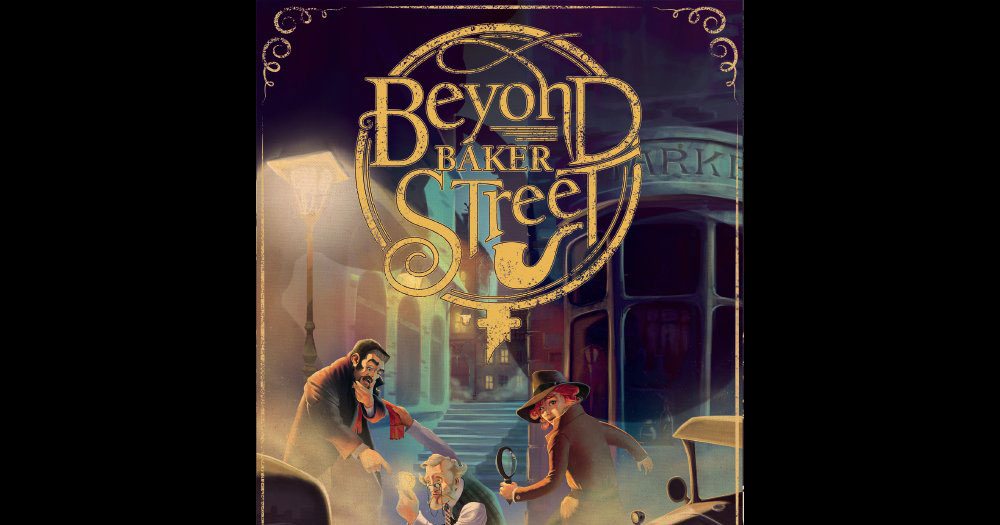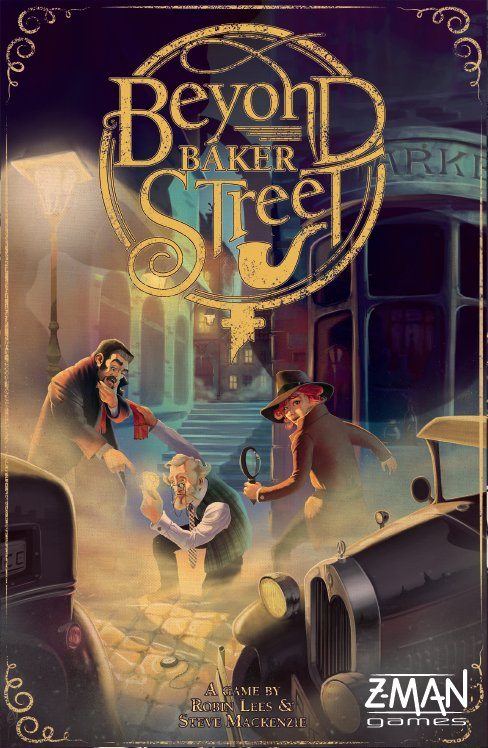It’s your chance to play detective, solving a mystery by assembling clues to pin down the suspect, the motive, and the opportunity. But be quick: Sherlock himself is also on the case. Can you work together to solve the mystery before he does?
At a glance: Beyond Baker Street is a cooperative game for 2 to 4 players, ages 10 and up, and takes about 30 minutes to play. It retails for $29.99; the US release date is July 29. The game uses Hanabi-style gameplay to keep players guessing while they work together toward the goal. I think 8 or 10 is a good minimum age, though both of my kids had trouble refraining from giving more information than they’re actually allowed to.
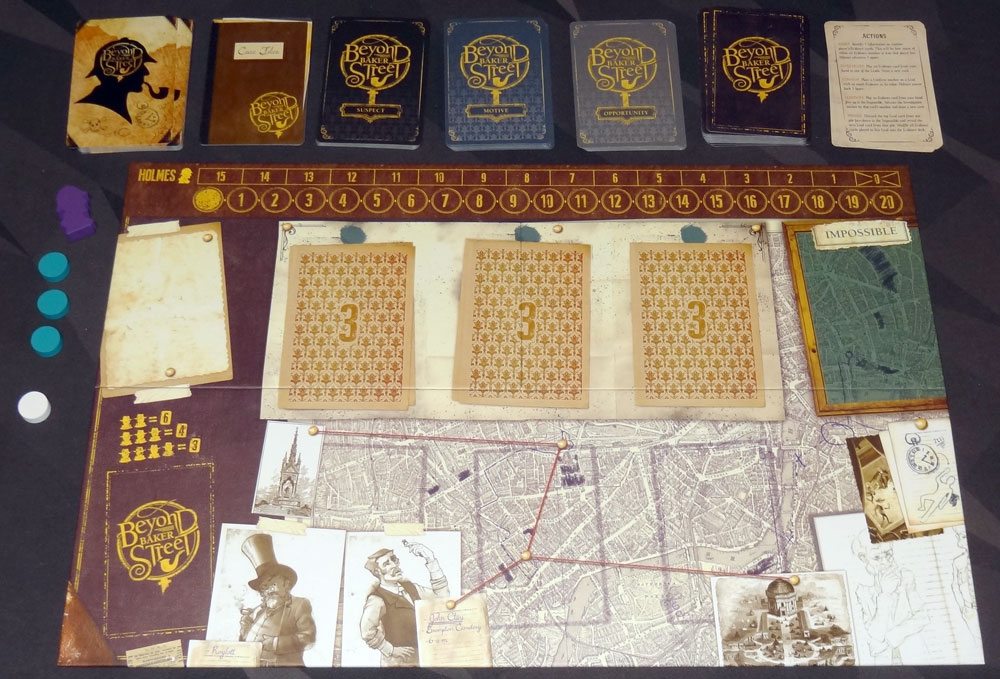
Components
- 1 Investigation board
- 3 Confirm tokens
- 1 Investigation token
- 1 Sherlock Holmes pawn
- 18 Character cards
- 6 Case File cards
- 24 Evidence cards (1–6 in 4 suits)
- 28 Lead cards (12 Suspects, 8 Motives, 8 Opportunities)
- 4 Reference cards

The components are pretty nice quality, and it all looks good and fits the theme. I particularly liked that most of the cards have flavor text on them. For instance, the Evidence cards, for which the most pertinent information is simply the number and suit, still have various snippets of information as if from a case file: “Suspect Movements: Wednesday supper time, trailed from Parliament Square to an empty property on Old Compton Street.” The Suspect cards have little portraits and descriptions included.
The game itself is primarily cards, but the board makes a nice area to keep things organized, and it has the Sherlock Holmes track and the Investigation track. The whole thing fits in a fairly compact package (though if you didn’t need the two tracks, you could fit the cards in your pocket).
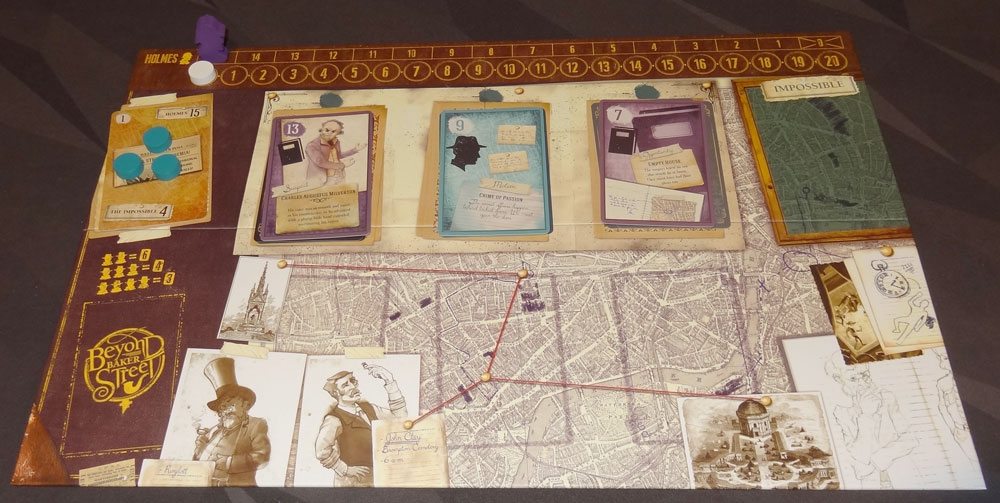
How to Play
Beyond Baker Street is a cooperative game, so you all win or lose together. As with many cooperative games, there is one way to win, and several ways you can lose. The goal of the game is to solve the mystery before Sherlock Holmes does, and you must achieve a specific set of circumstances: score exactly 20 points on the Investigation track, and confirm the Suspect, Motive, and Opportunity Leads.
One of the important rules of the game is that players hold their cards facing away from themselves (as in the game Hanabi), so you can see everyone else’s cards but not your own, and there are restrictions on what you’re allowed to tell people about their cards.
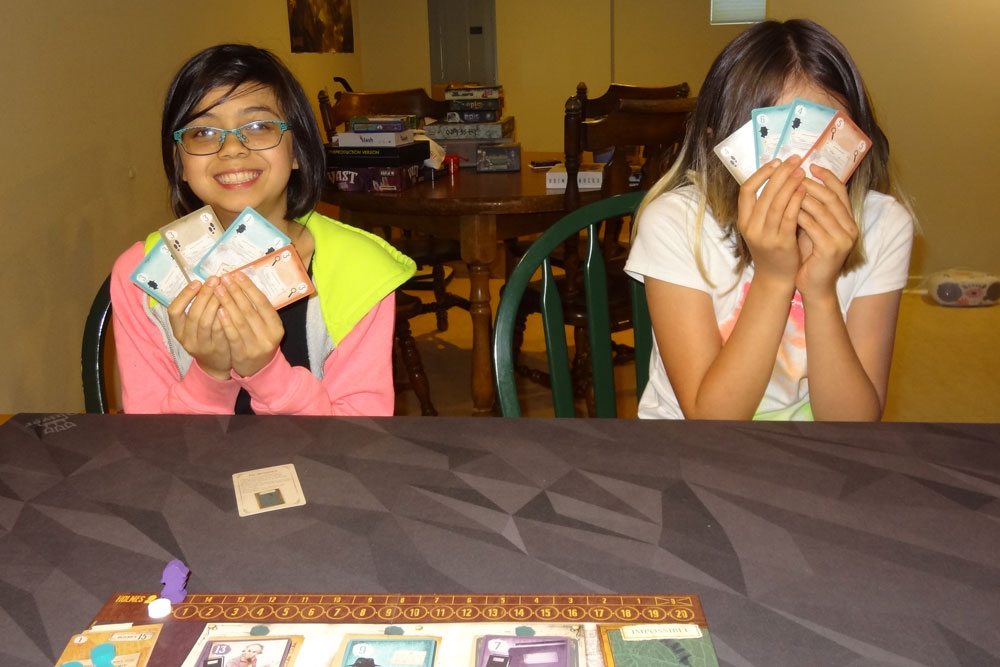
To set up the game, choose one of the Case File cards and place it on the board, along with the three Confirm tokens—this sets up the difficulty level and indicates Holmes’ starting position and how many cards can be put into the “Impossible” before incurring penalties. Put the Holmes pawn on the space indicated by this card. Shuffle each Lead deck separately and place 3 of each face-down in the three spots on the board for Suspect, Motive, and Opportunity, then turn the top card of each face-up. Place the Investigation token on the “0” space of the Investigation track. Shuffle the Evidence deck and deal some cards to each player (the more players there are, the fewer cards each player gets). The rest of the Evidence deck is placed on the board.
You may optionally deal each player a Character card, though those are not recommended for the first game—basically they introduce special abilities or restrictions, and can be used to make the game harder or easier.
On your turn, you must take one action:
- Assist: Give information to another player about their cards. Holmes moves forward 1 space.
- Investigate: Play a card to one of the Leads.
- Confirm: Place a Confirm marker on a Lead with exactly the right amount of Evidence on it. Holmes moves backward 1 space, and Evidence cards are turned face-down.
- Eliminate: Play an Evidence card into the Impossible, and move the Investigation marker forward equal to the card’s value.
- Pursue: Discard a Lead card into the Impossible and flip over the next Lead.
Whenever you have played a card, you draw back up at the end of your turn.
There are some specifics, of course: when you assist, you can name either a value or a suit, and then must point out all of the cards that share that number or suit in somebody’s hand. When you investigate, cards that match the suit of the Lead add up toward confirming it, but cards of the wrong suit will increase the Lead’s value, requiring more evidence before you can confirm. And if the Evidence value ever exceeds the Lead’s value, it becomes a spoiled Lead and is put into the Impossible, with the Evidence cards shuffled back into the deck.
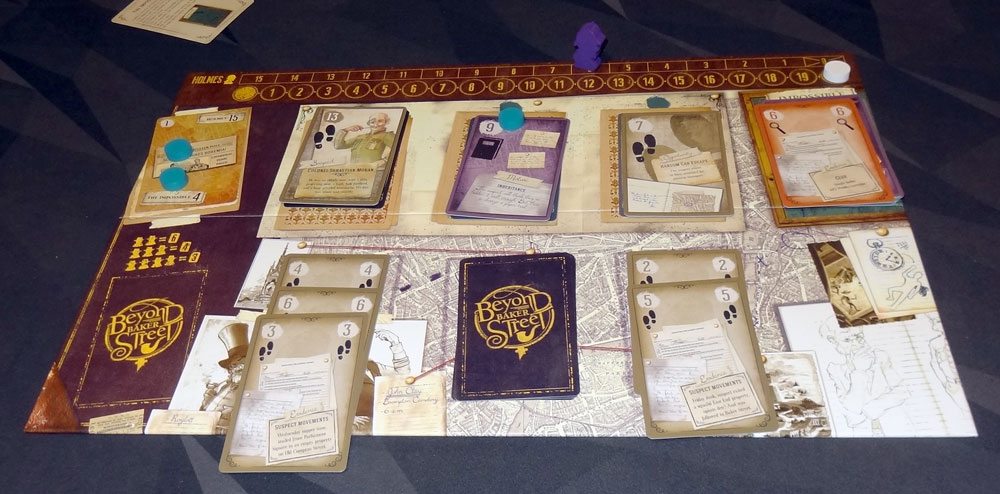
Any time you play cards into the Impossible above the number shown on the Case File card, Holmes moves forward one space.
Basically, your goal is to play exactly the right total number of Evidence cards on each Lead, and then confirm each lead—but you must also play Evidence cards into the Impossible to advance the Investigation track to exactly 20 before you do so.
You lose the game if:
- Holmes reaches 0.
- The Investigation marker goes past 20.
- The last card of any Lead type is put into the Impossible.
- You confirm the third Lead before the Investigation track reaches 20.
The Verdict
I’ll start with the confession that I have not actually played Hanabi myself, but the core mechanic is very similar to this one (and Bomb Squad, another cooperative game with outward-facing cards). You don’t know what cards you have, and so everyone spends turns giving hints about what you’re holding until you feel confident enough to play a card. There are specific cards you’re trying to play, and negative consequences for playing incorrectly. Beyond Baker Street isn’t just a rethemed clone of Hanabi, though—there’s a little more flexibility in the cards you can play, and the negative consequences of mistakes are different.
First: you’ll need to play the right totals for each of the Leads. Suspects have values between 11 and 13, Motives have values of 9 or 10, and Opportunities have values of 7 or 8. Each suit of Evidence cards has six cards, valued 1 through 6, so there are only so many ways to add up to the right Lead values exactly. So if you happen to have multiple Leads requiring, say, the footprints suit, you may not have enough cards to reach those values. That’s when the “Pursue” action comes into play, allowing you to toss a Lead and flip over the next one (and hope it’s a different suit). Although you need to hit each Lead’s value exactly, there is a little bit of fudge room: playing the wrong suit increases its value, so sometimes that can be used to allow somebody to play their Evidence card that would have overshot the value.
Another big difference is that the goal isn’t to play cards of every suit in numerical order: the focus is more on playing the right suits, and getting the right totals. The Investigation track is a good way to dump cards that don’t match a Lead’s suit, because you’ll need to get that to 20 exactly—but you generally don’t want to spend low cards on that, because every card put into the Impossible over the threshold moves Holmes one step closer to his victory over you.
Of course, all of this is moot if (like me) you can’t remember the hints other players give you. It’s important to have a system for how you hold your cards and where you put new cards when you draw them, or you’re going to be very lost very quickly.
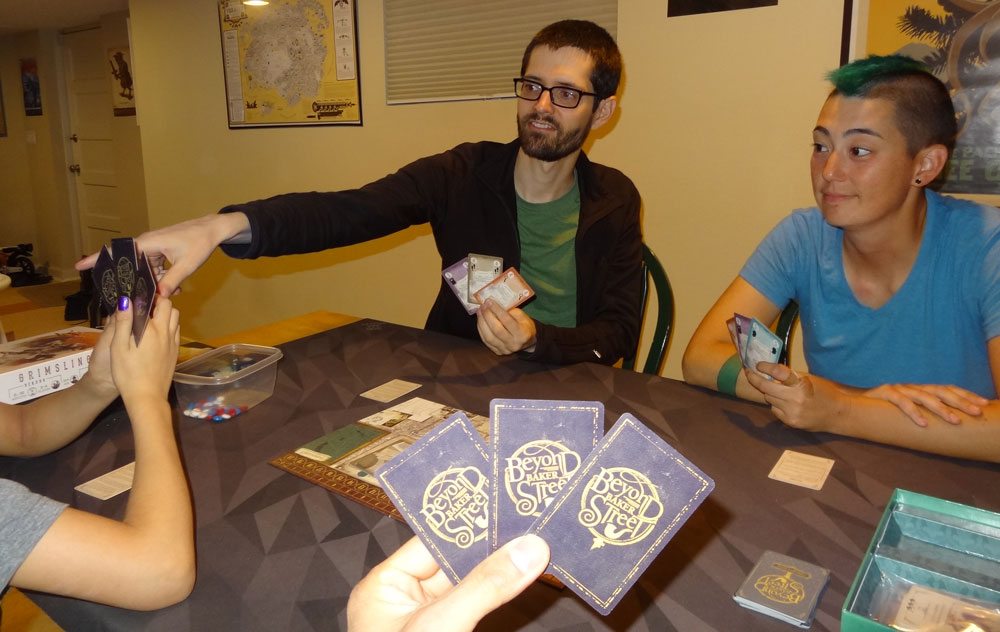
I’m still on the fence about whether the game works thematically or not. I do appreciate that there are characters from the stories, and that the various suits are types of evidence. Even the idea of “eliminating the impossible” is worked into the game by having the eliminated cards go into a stack called the “Impossible.” And the various characters do have strong thematic ties to their abilities, which is fun—there’s even a section in the rulebook explaining who the characters are so that you can understand the connections. However, it’s not really clear what exactly is going on with the Evidence and Leads. Why is it that the Suspect Abe Slaney can only be confirmed through paper trail Evidence, and not by talking to witnesses or looking for clues? How do you pin down Revenge as a Motive through footprints and carriage tracks, but not by physical documents? How come having more evidence than you need spoils a Lead? Regardless, since I’m a fan of Sherlock Holmes, I do like the mystery-solving theme.
And even though the card play doesn’t necessarily have a direct correlation to the mystery-solving in the game’s story, the game does require a mix of deduction and intuition. Sometimes you can look around at your teammates and immediately tell that the team already has the right cards to fulfill one of the Leads … which means that none of your teammates know. When somebody tells you that you’re holding a card of a particular suit, does that mean they want you to play it? Or should you wait until somebody else confirms the number? Each time you assist somebody by giving information, Holmes moves forward, so you have a limited number of assists before the game is over—and that number gets even smaller for the harder cases.

The Character cards add a really interesting spin to the game, giving each player a different ability (or penalty). They’re marked with pipe icons at the bottom: the more pipes there are, the easier the character will make the game. For instance, Inspector Hopkins (1 pipe) can never identify the Witness suit when assisting—that simply restricts the player, so everyone else has to pick up the slack. In contrast, Lady Hilda Hope (4 pipes) can assist twice on the same turn, while advancing Holmes only 1 space. With 18 characters to choose from, there’s a very good mix of abilities and effects, so you can change up the feel of the game and tweak the difficulty level in different ways.

The easiest Case File, which starts Holmes at 15 and allows up to 4 Impossible cards before penalties, is fairly easy. My kids and I won even though we ended up with a difficult mix of Leads that all had the same suit. But the last Case File starts Holmes at 8 and allows only 1 card in the Impossible: solving that case will definitely require careful attention, some card-counting, and probably a few leaps of intuition. I’m not ready for that one yet. Each of the Case Files has an image of a newspaper with a headline referring to a particular Holmes story—”Scandal in Bohemia,” “Hound of the Baskervilles,” and so on.
Overall, I found Beyond Baker Street to be a tricky cooperative game that takes Hanabi’s core mechanics and puts a fun thematic twist on them. It’s kid-friendly, though younger players may have difficulty keeping their mouths shut and not giving more information than is technically allowed; my nine-year-old in particular is unable to keep a poker face, which makes the game a little easier than intended. I’m looking forward to getting into some harder case files after we’ve had some practice, and the characters will keep things fresh for a lot of replay value.
Beyond Baker Street will be released in the US July 29, so look for it in stores and online then. The game is afoot!
Disclosure: I received a review copy of this game.
